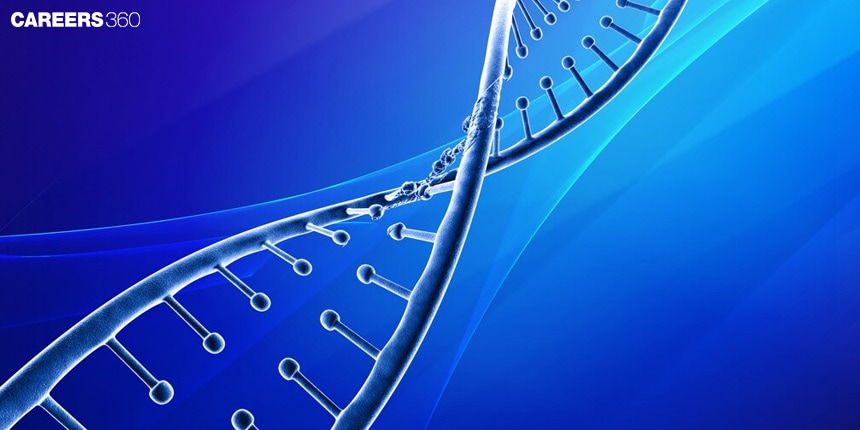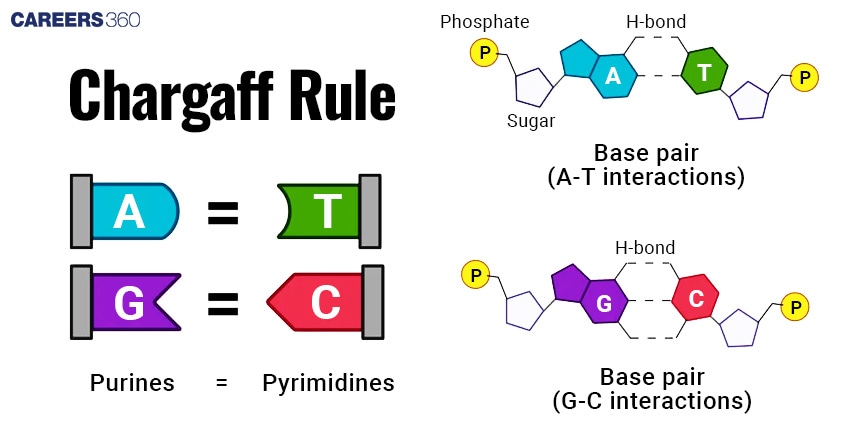Chargaff Rule: Overview, Discoveries & Rules
What Is The Chargaff Rule?
Chargaff's rule is one of the very important rules of molecular biology given by Erwin Chargaff, an Austrian biochemist in the mid-20th century. He stated that in a DNA molecule, the amount of A is equivalent to T, while that of G is equivalent to C. These findings were interpreted to mean that A is always bound to T, and G is always bound to C. The complementary character of the DNA double helix is also derived from his findings. His discovery was crucial in the identification and understanding of the function of DNA and its structure concerning hereditary and genetic information flow.
NEET 2025: Mock Test Series | Syllabus | High Scoring Topics | PYQs
NEET Important PYQ's Subject wise: Physics | Chemistry | Biology
New: Meet Careers360 B.Tech/NEET Experts in your City | Book your Seat now

The work of Erwin Chargaff was important in the study of DNA because it came along when. While most scientists during the 1940s and 1950s were racing to decode the molecular structure of DNA, elucidating the function of DNA in living organisms was another matter. Chargaff preciously carried out experiments with the painstaking analysis of the nucleotide composition of DNA from several species. These results indicated that the proportion between A and T and G and C is proportional in a species, but it varies between different species, then giving what has been valuable evidence of a base-pairing mechanism. Chargaff's rules served as the basis for the Watson and Crick model in envisioning the double helix model, which eventually changed our perception of genetics.
Chargaff's First Rule
Referred to as a base pair rule, Chargaff states how adenine-thymine (A-T) and guanine-cytosine (G-C) precisely base pair across the DNA molecule.
Adenine forms the same base pairs with thymine, always the same, irrespective of the DNA sample.
Similarly, guanine always forms pairs with cytosine in the same number.
For hydrogen bonding between the two complementary bases, this is the combination that is there for A-T and G-C.
In between adenine and thymine, there are two hydrogen bonds, and between guanine and cytosine, there are three such hydrogen bonds that further help cross-connect to stabilize and maintain some uniformity in the twist of the DNA double helix.
And that's a critical point in the structurally balanced presentation of DNA.
According to Chargaff's rule, the quantity of purines (adenine and guanine) contained in the double-stranded DNA molecule is equal to the volume of pyrimidines (thymine and cytosine).
From experimental data on DNA from various organisms, this base composition was found to be typical for DNA, independent of the concerned species.
The fact that these ratios were so constant was compelling evidence for the particular pairing mechanism, later confirmed by the structural model of DNA proposed by Watson and Crick.
Chargaff's Second Rule
Chargaff's second rule ponders the question, of how are the complementary base pair ratios different from one species to another.
His second rule said, that within a single species, the ratio of adenine to thymine and the guanine to cytosine remains constant. However, the ratio can greatly differ between species.
For example, the DNA of humans has a distinct A/T and G/C ratio compared to bacterial DNA.
These intra-species consistency and inter-species variability further highlight the specificity of the genetic code and the distinct DNA sequence for each organism.
Changaff's second rule supports the double helix model. Invariant ratios in all species guarantee that it is the DNA molecule that maintains the helical form and can, during cell division, copy with high fidelity.
Probably of no less consequence, this invariant rule also, most directly, identifies the genetic differences between species that follow from differences in DNA sequence and knowledge of those differences is central to relationships among species, genetic inheritance and molecular mechanisms of individual biological processes.
The second rule decrees that base pair ratios must hence be important in maintaining the fidelity with which genetic information is transferred.
Diagram: Chargaff’s Rule
The below diagram indicates both the laws given by Chargaff about DNA pairing

Application Of Chargaff's Rules
Of the base pairing established by Chargaff, Chargaff's rules were decisive in deducing the structure of the double helix of DNA by Watson and Crick.
The only way in which two strands of DNA would stick together in a double helix is this sort of base pairing. Watson and Crick used this data to continue their model that the DNA is antiparallel and that is held together by hydrogen bonds.
Base pairs interacting with complementary ones, one of the strands of the DNA serves as a template for the synthesis of another new complement strand.
In modern genetic research, Chargaff's rules underlie multiple applications, in particular, in DNA sequencing and genomics.
The predictable base paring lodge a possibility for scientists to sequence DNA and read off genetic information rather accurately.
These rules are very fundamental in forensic science, as everyone has a unique sequence of base pairs in their DNA.
Moreover, through ancestry tracing, it is possible to find the genetic relationship between individuals and populations.
Their knowledge of these rules has led to advances in genetic engineering, biotechnology, and personalised medicine.
Conclusion
The contributions of Erwin Chargaff in the field of molecular biology are noteworthy and have a lasting impact on an understanding of DNA. Chargaff's rules thus formed the basis for the double helix structure that was discovered and has since been in great use in genetic research. The clear explanation of the kind of specific base pairing and consistency of base pair ratios as was explained in his work has increased our understanding of the replication of DNA, genetic inheritance, and molecular explanation of the various aspects of life. These results continue to hold an influential role in current scientific research and hence emphasise the endurance of Chargaff's rules in genetics.
Recommended Video On Chargaff's Rule
Frequently Asked Questions (FAQs)
Chargaff's rule states that in the DNA of every cell of all organisms, there will be an equal ratio of pyrimidine bases to purine bases, wherein A is equal to T and G is equal to C.
The rule is important in determining the structure of DNA and its process of replication. In addition, this rule confirmed the evidence of realising a double helix model advanced by Watson and Crick.
Chargaff worked out large chemical analyses of DNA from different species and showed constant ratios in the base pairs.
They are among the essential tenets of genetics, impacting understanding related to the structure, replication, and genetic inheritance of DNA.
They underlie techniques of DNA sequencing and are thus of central importance to genomics, forensic science, and genetic engineering.
Also Read
29 Nov'24 09:31 AM
19 Nov'24 09:26 AM
18 Nov'24 06:45 PM
18 Nov'24 09:29 AM
18 Nov'24 09:18 AM
18 Nov'24 09:01 AM
18 Nov'24 08:37 AM
16 Nov'24 03:45 PM